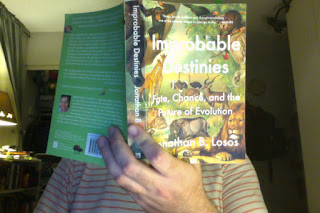Lucas Blogs About Improbable Destinies
 |
| This book cover brought to you by Wes Anderson. |
So, what's this book's deal?
Well, since you asked, Improbable Destinies: Fate, Chance, and the Future of Evolution examines experiments in evolutionary biology meant to test whether evolution is the random, non-repeatable result of every selection pressure that's ever acted upon a species or whether it is limited to the possibilities present in an organism's genome, meaning it can be predicted and will inevitably give rise to to the same convergent phenotypes.
You're not expecting me to roll out the "English, please," cliche, are you?
No. Anyway, this is a popular science book about evolutionary biology by Jonathan B. Losos, a herpetologist who has conducted evolutionary studies on anole lizards in the Caribbean. Specifically, to test the hypothesis that ground-based predation pressure will lead to natural selection for shorter legs in order for increased climbing stability on thin branches (I may be oversimplifying a bit). As it turns out, one of the more contentious debates in evolutionary biology is whether evolution is driven more by random chance or genetic determinism. There's evidence on both sides. Examples of evolutionary convergence (unrelated species evolving in similar ways in response to similar pressures) abound in nature, and can seem to be the rule. One example from the book that's stuck with me is that African and North American porcupines don't actually share a common ancestor (well, at least not a similarly spiky ancestor). They each evolved separately from a non-spiky rodent. On the other hand, there are several prominent examples of animals which have evolved unique solutions to fill their ecological niche: humans, kangaroos, and the noble platypus spring to mind (the first and last of those feature prominently in the book).
Okay, nerd, we get it. So, you said that Losos examines evolutionary biology experiments, so mostly lab stuff with microbes?
No, in the last century there have been several studies of evolution conducted in the field. As it turns out, small islands and the small habitats on said islands can be ideal for staging experiments on animals with relatively quick reproduction cycles. The author's own experiments with anoles spring to mind, as well as experiments to see if the presence or absence of predators will lead to selection of gaudy colors in guppies. There are also plenty of controlled laboratory experiments as well. Including a Long Term Evolution Experiment (LTEE) on e. coli bacteria that has been going on for more than 64,000 generations.
That's a lot of generations.
It is, although, I think the book drags a little in the sections on lab experiments. Microbes just aren't as fascinating as animals. Even if they are better suited for evolution studies.
When you say it drags . . .
Well, it isn't necessarily through any fault of the author (aside from the fact that he's chosen the subject matter), it's just that I wasn't as interested in those sections (although the information about evolutionary biology was fascinating) because microbes just aren't that exciting. In any case, Losos is an engaging writer. The tone is occasionally conversational, with humorous asides and an introduction that uses the teaser for Pixar's The Good Dinosaur to discuss the question of whether you can predict the course evolution will take for any given change in environment. The book is written to be understood by a layperson, though admittedly a layperson who already has a basic grasp on science generally, and biology specifically. Some readers may want to have their phones handy in case they come across unfamiliar terminology, but he does a good job of avoiding too much technical jargon.
Wait a minute? Are you suggesting that a book written by a Ph.D. in his area of study actually manages to be accessible to a wide audience while also not talking down to said audience?
I am suggesting that, yes. Losos does an excellent job of explaining the methodology of experimental science and the ideas behind evolutionary biology at what we might call the "Goldilocks" level of comprehensibility. It also doesn't hurt that it has a lot of illustrations (which are excellent, by the way, kudos to illustrator Marlin Peterson).
So, I gotta ask: is evolution random or deterministic?
Not to give away the ending, but Losos ultimately comes down on the same side as Stephen Jay Gould, concluding that evolution is ultimately unpredictable. That isn't to say that it's completely random, but more that you have to consider the totality of a lifeform's evolution (environmental factors, previous mutations, selection pressures, etc) when asking whether it's likely that that exact lifeform would evolve again if you started from scratch (or "rewound the tape" as Losos quotes Gould).
All right, so I take it you liked this one?
Oh, yeah, I'd definitely recommend it to anyone who's looking for a fun popular science-y book and wants to know more about evolution.
Well, you're certainly becoming more firm in your recommendations or lack thereof.
Well, I am still qualifying them.
Is it possible that recommendations can't or even shouldn't be universal?
‾\_(ツ)_/‾
Improbable Destinies: Fate, Chance, and the Future of Evolution by Jonathan B. Losos, illustrated by Marlin Peterson, Riverhead Books trade paperback edition, August 2018 (originally published in hardcover in August 2017), 335 pages, pairs well with a glucose medium and a gene mutation that allows you process citrine in the presence of oxygen (see, I was paying attention in the part about e. coli)
Links:
Here's Jonanthan Losos's faculty page at the Washington University in St. Louis, if you're into that kinda thing.
He's also worked at Harvard, where there's a laboratory named for him.
Comments
Post a Comment